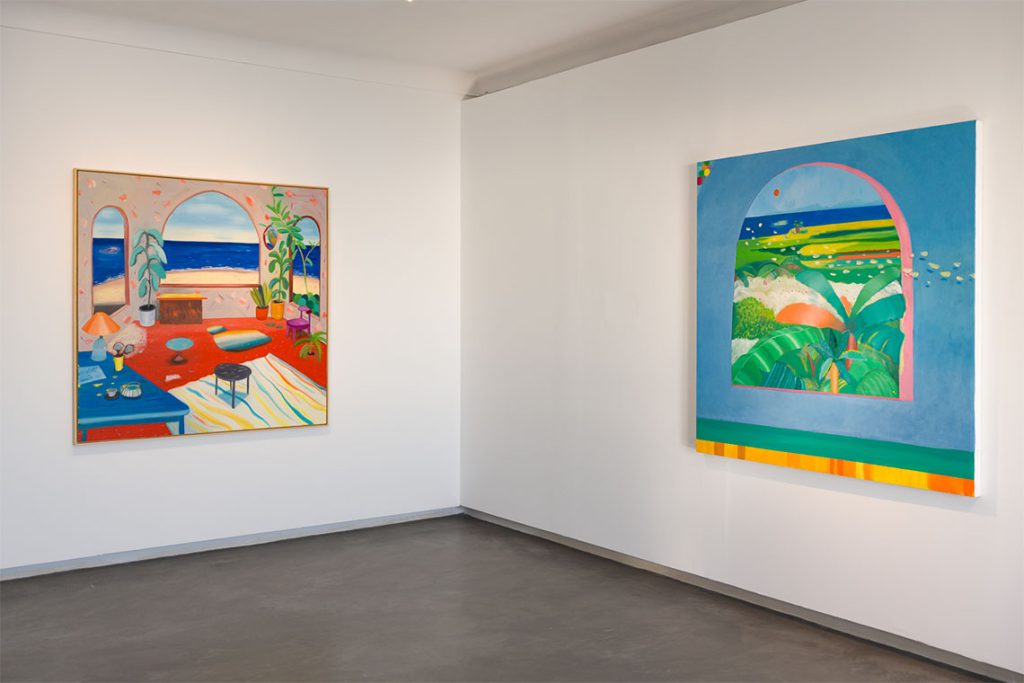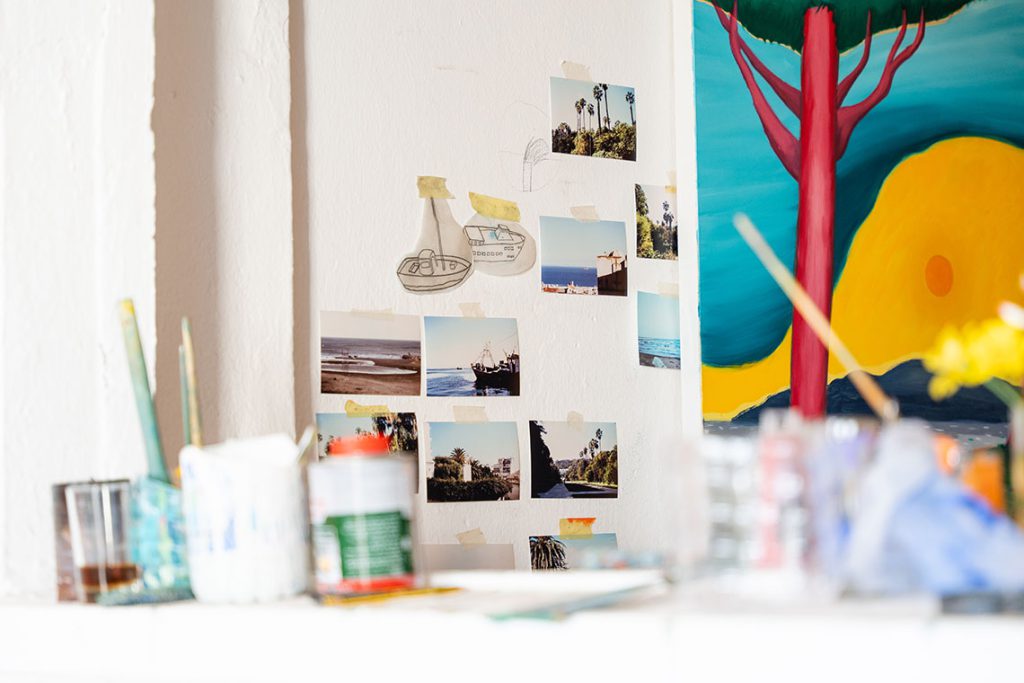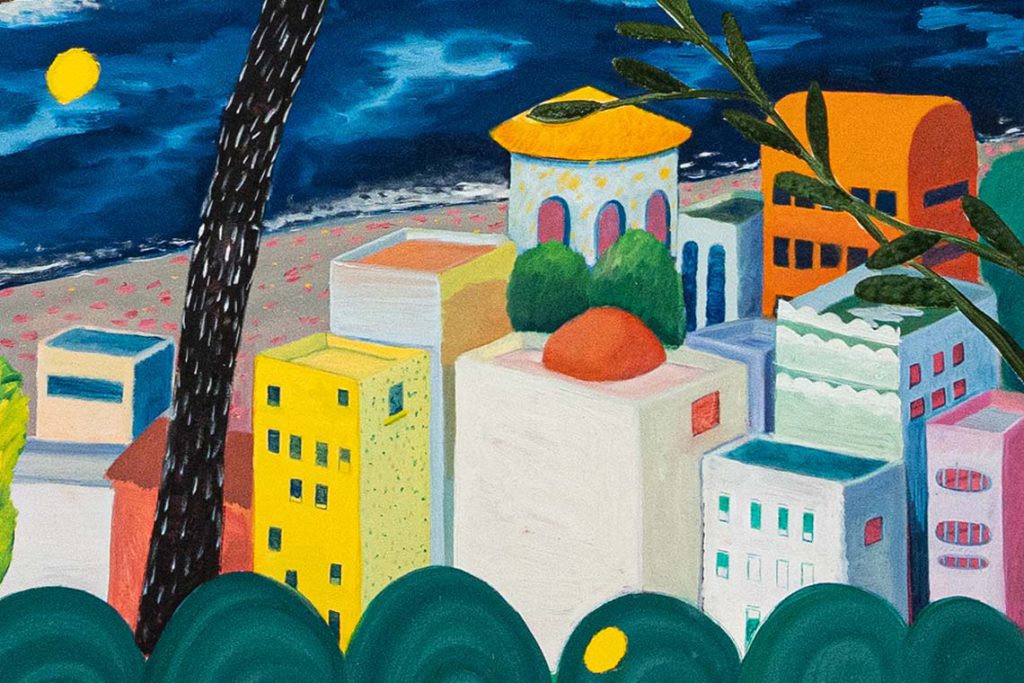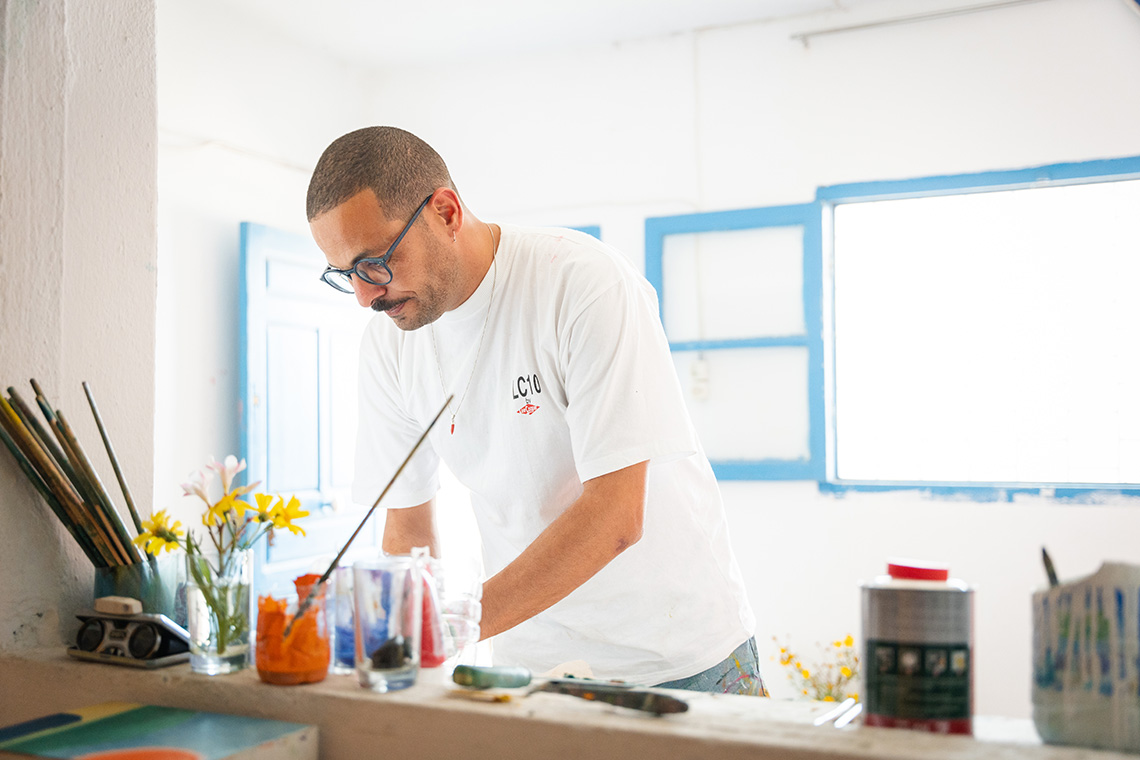Ever mindful of his context, the artist crafts a wistful and ethereal path through colour and light.
The beauty of our surroundings is often heightened in the mind’s eye, becoming a vision that could only be faithfully reproduced by an expressive art form like painting. This is exemplified beautifully by the vibrant landscapes of Fares Thabet, in which sandy beaches blush pink, seas fade into turquoise green, and skies turn tangerine orange at dusk. These havens of tranquillity exist only in the imagination, yet they bear traces of human habitation in the vaguely eerie manner of Giorgio de Chirico. Sometimes we spot a lone figure or a boat drifting in the distance, as is the case with Départ (2024) and L’Escargot rentre dans son palais 13 (2024). At other times, we spy entire abandoned cities that have become at one with their environment, as in Houses (2021) and Le soleil défonce les songes et les chimères (2024).
A large collection of new canvases was included in the exhibition Un bâteau, sans naufrage et sans étoile, which opened at Selma Feriani Gallery in Tunis over the summer. They had been inspired by a trip that Thabet took last winter to Algeria, the homeland of his mother, who was born in France during the Algerian War of Independence. “Our family relationship with the country has always been complicated, so I decided to take a solo trip to gain a more personal perspective on the country,” he says. “It was an intense journey that greatly influenced my imagination and allowed me to collect visual and literary material, which I used to develop my practice.”

The visit also offered a new vantage point on the same North African landscape that Thabet has returned to throughout his mature painting practice. “This time, I felt more at ease emphasising elements, exaggerating them, or giving them dreamlike qualities,” he explains. Even back home in his native Tunisia, Thabet’s everyday surroundings offer plenty of inspiration, with his studio located in the bay of Tunis, near the ancient ruins of Carthage.
Born in 1982, Thabet spent his earliest years in the small coastal town of Hammamet. The sea, with its innate majesty and strange capacity to both entice and intimidate, would leave a strong impression on the artist, who for many years felt estranged from it. At the age of nine, his mother took him and his sister to live in the landlocked Spanish capital of Madrid, which was at that time “in the midst of a post-Franco transition”. It was an overwhelming adjustment. “We had to learn a completely new language and adapt to a new culture,” he recalls. After leaving school, Thabet worked in various odd jobs but found himself with no direction until he took a trip back to Tunisia to stay with his father, who was by then working full-time as a ceramicist. Noticing that the young Thabet, then in his early twenties, seemed lost, it was he who first suggested his son go to art school.
Back in Madrid, Thabet started a three-year course at the Francisco Alcántara School of Ceramics. It was in the evenings, however, that he nurtured what would later become his true passion by taking extra drawing lessons in preparation for the entrance exam to study fine arts at the Complutense University of Madrid. There, finally, he felt the pull towards painting, which he admired for its simplicity. “By using only pencils or paints, one can develop ideas in a personal way without resorting to more technological means,” he explains. He also began taking advantage of the Spanish capital’s world-class museums, such as the Reina Sofia and the Prado. “My friends and I would spend entire days visiting exhibitions and discussing them,” he says. “I had a teacher who claimed to have a favourite artist every week. I would say the same applies to me.” Historically, the biggest influence came from Henri Matisse, in particular his vivid interpretations of Morocco, which he visited twice. Thabet’s main contemporary references as a student were Belgian artist Francis Alÿs and Iranian filmmaker Abbas Kiarostami.

After graduation, Thabet decided “to try my luck in a country other than Spain, avoiding the European destinations some of my classmates chose.” Although his father had since died, the idea of returning to Tunisia became a longing, and eventually Thabet decided to reestablish his father’s pottery workshop in a new location and with new ideas. For the next ten years, he made a living this way and only continued to paint in his spare time.
Through this very private endeavour, which Thabet never imagined would find a larger audience, he fell in love with the local landscape. “I have always felt that the geography in Tunisia is very open and horizontal,” he notes, “which has allowed me to create more expansive spaces in my paintings and gain a broader perspective.” Visions from real life of an open sea or rolling hilltops were transformed in the artist’s imagination, a process that often involves reference to photographs, whether found in a book or taken by Thabet himself. On his daily walks, he likes to record his surroundings, making intentionally low quality black-and-white images so that a more expressive palette can be introduced to the composition at a later stage. “I always strive to have an aesthetic experience in my mind before starting the painting,” he says. Although he may jot down some notes at this stage, he never makes detailed preparatory sketches.

Rather, once he puts paint brush to canvas, Thabet continues to invite the unexpected. The colour scheme is determined first, often with one dominant tone in the background, with which all subsequent additions aim to produce a sense of harmony. Form and pictorial detail come later, built up over time. “What is interesting for me is discovering what happens in the painting as I create it and the changes that occur along the way,” he says. “For me, the act of painting is like embarking on an unplanned journey. However, I always keep colour work at the forefront.”
Thabet’s big break as a painter would eventually come as a surprise. He had received a request to visit his workshop from Selma Feriani, whose eponymous gallery opened in London in 2013 but who now has a second location in the town of Sidi Bou Said, some 20 kilometres from Tunis. She chanced upon some of Thabet’s canvases stacked in a spare room and suggested he participate in the gallery’s annual summer exhibition of 2020. His first solo show, On a Blade of Grass, was organised for the following year, finally giving Thabet the confidence to abandon his pottery practice, rent a new studio, and dedicate himself entirely to painting.
“Since painting is a non-verbal language, I believe that something from the subconscious reveals itself during the process,” he affirms, adding that he does not necessarily see the works in his shows as a series. Literature remains an inspiration, but not a prerequisite. “If the painting calls for it, I may incorporate elements I have encountered in literature,” he says, citing the Saint Lucian poet Derek Walcott as a particularly important inspiration. Above all, however, each of Tabet’s works is a unique and intuitive expression that arrives to us directly from the artist and from what he calls his “personal universe”.



